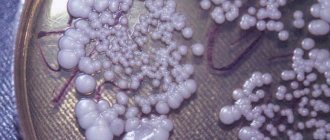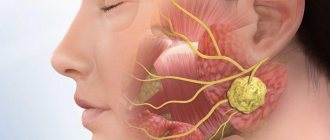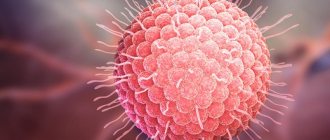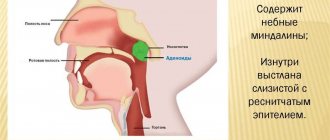Symptoms
The only symptom is a rash on the skin in the form of small flesh-colored or lighter-colored nodules (molluscs). The contents of the nodules are white and can give the rash a pearly appearance. In children, they appear on any part of the body, quite often on the chest and face, and almost never on the hands and feet. When you press on the nodule, a white mass is released from it, the consistency of which is similar to boiled cereal.
Unlike chickenpox or herpes, these rashes do not hurt, are almost never itchy, and may not cause any discomfort at all. The rash can be a serious cosmetic problem if multiple molluscum are localized on the face.
Occasionally, these nodules can merge, then a so-called giant clam is formed - a large formation on the skin with a depression in the center (navel). Most often, this happens if the child has reduced immunity as a result of an illness or lack of personal hygiene.
Manifestations during sexual transmission
In a situation where infection occurs through sexual contact with a sick person, papules form in the genital area and adjacent areas - in the groin, on the labia, on the head of the penis, as well as in the lower abdomen and thighs. Since the infection is transmitted through tactile skin-to-skin contact, the use of a condom by a man cannot protect against infection. In this case, the risk of molluscum contagiosum appearing directly on the penis is only reduced.
In women, with sexual infection, damage to the mucous membranes of the vagina, cervix, and outer tissues of the labia is often possible. Otherwise, the localization is similar to that in men: in the pubic area, perineum, lower abdomen and thighs. But, when using a condom during sexual intercourse, the risk of the virus entering the mucous membranes of the internal genital organs is much lower.
Mixed localization of rashes
In some cases, you can find mixed localization of papules, when they spread almost evenly over the patient’s skin. This happens during the secondary spread of infection, when the pathogen enters adjacent areas from the primary foci. The reasons for the appearance of new rashes are involuntary scratching, attempts to independently open papules without following antiseptic rules. Because the discharge from the rash contains a large number of active pathogens, it is extremely contagious. When they come into contact with clean areas of the skin, even in small quantities, they can form new foci of inflammation.
With reduced immunity, when a person suffers from HIV infection, chronic fatigue syndrome, or takes certain types of steroid drugs, it is also possible for papules to spread widely throughout the body. In this case, the poxvirus behaves more aggressively, quickly spreading across the skin. The number of foci can reach 15-20, or even more. Along with the appearance of new papules, old ones practically cannot be cured, due to the reduced immune response of the sick person’s body.
Complications
Despite its apparent harmlessness, molluscum contagiosum can be complicated by other skin diseases, primarily purulent ones, when a bacterial infection is added to a viral infection.
Signs of bacterial infection:
- Redness and swelling of the skin around the rash element.
- The appearance of pain in the area of the molluscs.
- The appearance of purulent discharge from the rash.
- It is possible that the temperature may rise and the bacterial infection may spread to other elements of the rash.
The cause of purulent inflammation is often that children scratch or try to remove the mollusks on their own, leaving an entry point for infection.
Diagnosis of molluscum contagiosum
Making a diagnosis when a person is infected with molluscum contagiosum is usually not difficult. In this case, the clinical picture is mainly taken into account, and if the doctor observes a questionable situation, then a histological examination will be informative, during which molluscan bodies are found in the cytoplasm of epidermal cells. It is important to differentiate this disease from certain types of lichen , warts , and epithelioma .
A microscopic examination of the contents of the nodules is also carried out, which reveals special ovoid (mollusc) bodies characteristic of this disease, as well as keratinized cells of the epidermis.
If molluscum contagiosum recurs too often, a specialist may advise the patient to be tested for HIV, since this disease is very common in patients who suffer from immunodeficiency .
However, in most cases, the diagnosis can be made based on a thorough visual examination. If nodules affect the genital area, then patients are also recommended to undergo additional tests to identify other diseases that are sexually transmitted, in particular genital herpes .
Infection
The causative agent of the disease is a virus related to smallpox viruses. It affects exclusively the skin, so when the last element of the rash is cured, it is removed from the body.
The source of infection can only be a sick person . Transmission of infection occurs through prolonged skin-to-skin contact and when sharing bath accessories and toys with the patient. Children are often infected in swimming pools, kindergartens, and country camps. The incubation period of the virus is very long, the first rash may appear only three to four, and sometimes eight weeks after infection.
After treatment, temporary immunity to the virus remains for two to three months, after which re-infection and illness are possible. Vaccination against molluscum contagiosum virus is not possible.
Prevention
Prevention of some diseases that are easily transmitted by airborne droplets is practically impossible, since the only way to avoid infection is to avoid contact with the patient, but when he has an incubation period, this is even more difficult, because there are no external signs of infection.
As for diseases transmitted by contact or household contact, it is necessary not to approach the patient closer than 30-40 cm, and not to share towels, dishes and other items in the house with him. If a family member has suffered an infection, then all clothes and bedding that he/she used must be washed at high temperatures and the dishes treated with steam. Also, to prevent skin infections, you should monitor your health and avoid situations that reduce the body’s immune function.
The prevention of some skin viral infections is vaccinations, which are prescribed from childhood. You should not be afraid of these procedures, because thanks to them, from an early age the body receives immunity to pathogens.
Viral skin diseases are common, especially among children, since pathogenic microorganisms are easily transmitted by airborne droplets, contact and household contact; a number of reasons reduce the body’s ability to resist the development of the disease. Symptoms for different diseases differ, but all of them are characterized by the appearance of rashes on the surface of the skin, deterioration of well-being and itching in the area of the rash. Treatment should be carried out by a dermatologist or therapist; to clarify the diagnosis, differential diagnosis must be carried out.
Treatment
General treatment of molluscum contagiosum is based on observing the rules of personal hygiene for the child and his parents, and strengthening the immune system. For this purpose, the doctor may prescribe various immunomodulators, vitamins and restorative drugs.
When it comes to treating skin manifestations, doctors have different opinions. It is believed that uncomplicated molluscum contagiosum goes away on its own without special treatment , just cleanliness is enough. Elements of the rash disappear without a trace; in extremely rare cases, areas of depigmentation (light areas that are not subject to tanning) may remain in their place. Therefore, many doctors are of the opinion that it is not necessary to treat skin rashes, especially since the treatment procedure can be painful.
Other experts, on the contrary, consider treatment mandatory in order to avoid inflammatory complications and the formation of giant clams. The decision about whether treatment is needed rests with the parents.
Methods for removing rashes from molluscum contagiosum:
- Mechanical removal using tweezers or a sharp spoon, after which the affected area is cauterized with an iodine solution. The procedure is quite painful, and children have a hard time with it. For severe rashes, local anesthesia is used.
- Cryoremoval of shellfish . It is carried out using liquid nitrogen. It is applied to the elements of the rash with a special applicator; the removal procedure takes about a minute. After it, the mollusk turns white, after a few hours the skin in its place turns red and swells, a blister forms, which heals on its own after two weeks. The area from which the rash was removed should not be wet for another five days after the procedure.
- Laser removal . Its essence is that the mollusks are removed layer by layer using a medical laser, until a micro-wound is formed, which is treated with a solution of potassium permanganate. A crust forms in place of the rash element, which disappears after two weeks, as with cryoremoval. This method is more gentle than mechanical or cryoremoval, but is still painful.
- Treating the skin with products for warts - preparations based on salicylic acid, tretrinoin, benzoyl peroxide and others. This method does not remove rashes quickly, but does not injure the skin, so it is most often used in children.
After removing the rashes by any of the methods, scars and areas of depigmentation , so for children, the removal of molluscs is usually not carried out at all or is limited to treating the skin with preparations for warts.
During treatment, the child can attend school or kindergarten, but you must ensure that he does not scratch the rash and uses only his own bath accessories.
Symptoms
Molluscum contagiosum in children manifests itself as hemispherical formations. These may be single, or several may appear at once. Visually they are similar to warts and pimples. A distinctive feature is that the top seems to be flattened. The formations are dense to the touch. The mollusk has a round shape. The skin tone does not change - the formations are painted the same color as the surrounding tissues. In rare cases, the area where the virus is localized seems to be covered with wax and acquires a pinkish tint. Possible visual resemblance to mother of pearl.
If you remove molluscum contagiosum from a child or adult, you may see a whitish filling of the area. Outwardly, it is similar to cottage cheese. This substance is extremely contagious. If you open a tumor carelessly at home, you can easily spread the virus. The risk of such a development is relatively low, since molluscum contagiosum does not provoke burning, itching, scabies, discomfort, or pain, but in some cases mild itching is possible. Scratching the area will make the discomfort worse. There is a risk of infectious processes and inflammation of the skin.
If you examine the portfolio of specialized clinics for photos of molluscum contagiosum in children, you will notice that formations caused by the virus may be covered with a yellowish crust. If the disease develops according to this scenario, the use of antibacterial drugs will be required to eliminate the secondary source of infection.












